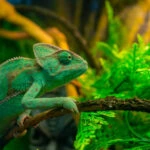Chameleonovite explains the biting behavior of chameleons, what triggers it, how to prevent it, and what to do if it happens. Learn the signs, reasons, and care tips that make your chameleon feel calm and safe.
What Is Chameleonovite?
Chameleonovite is not a real medical condition or product. It’s simply a way to describe the defensive biting behavior seen in chameleons. This reaction happens when a chameleon feels cornered, stressed, or unsure of what’s happening around it. These reptiles are naturally shy and prefer to stay unnoticed, so when they bite, it’s usually because they feel they have no other option left.
Chameleons rarely start interactions with aggression. They don’t want conflict, but they will defend themselves if they feel unsafe. Understanding what leads to this kind of behavior helps owners prevent unnecessary stress for their pets and themselves.
Why Chameleons Bite
A bite from a chameleon doesn’t happen randomly. It’s a form of self-defense, not a show of dominance or anger. When they feel threatened, trapped, or uncomfortable, they resort to biting as a means of coping with the problem. The most common reasons include fear, territorial instincts, stress from poor living conditions, or hormonal changes in females, particularly when they are carrying eggs.
Male chameleons are more territorial and may react strongly if another chameleon or even a hand enters their space. Females, on the other hand, may bite when they’re pregnant or want to be left alone. Stress from too much handling or bright lighting also makes them defensive. According to information shared by reptile care experts, biting is almost always a final act after the chameleon has already shown several warning signs.
Recognizing the Warning Signs
Chameleons give clear signals before they bite. They use color, body posture, and behavior to communicate discomfort. When a chameleon changes color to darker or duller shades, that usually means it is frightened or agitated. It may puff up its body to look larger or open its mouth as a warning. Sometimes, you’ll hear a soft hiss, which is another way it tries to scare you off without physical contact.
Ignoring these signs and continuing to handle or move too close can lead to a bite. Paying attention to these early warnings is the best way to prevent harm. Once a chameleon starts showing defensive behavior, it’s important to give it space and time to calm down.
What to Do If a Chameleon Bites
If a chameleon bites you, stay calm. The bite might sting, but it rarely causes serious harm. Their teeth are small and meant for catching insects, not tearing flesh. The worst thing to do is to pull your hand away suddenly, because that can injure both you and the animal. Instead, remain still and gently lower the chameleon onto a surface until it releases its grip.
Afterward, wash the bite with soap and water, apply a mild antiseptic, and monitor it for any swelling. Most of the time, it heals quickly without complications. It’s also a good idea to check your chameleon’s mouth afterward because it could have hurt itself during the bite.
How to Prevent Chameleon Biting
Most bites can be prevented by understanding the animal’s limits. Chameleons are not social creatures and do not enjoy frequent handling like some other reptiles. The best approach is to move slowly and let the chameleon decide when to come to you. Always approach from the front, where you can be seen. Never grab it from above, as that triggers a defensive reaction.
Ensure the chameleon’s enclosure is properly set up with the correct temperature, humidity, and lighting levels. Avoid handling them when they are shedding, eating, or displaying signs of stress. Maintain a quiet and predictable environment to minimize fear responses. Over time, a calm routine helps the animal associate your presence with safety rather than danger.
Comparing Chameleons to Other Reptiles
Chameleons are more reserved than other reptiles, like bearded dragons or geckos. Bearded dragons are usually friendly and rarely bite, while geckos are fast and curious but sometimes nip. Chameleons prefer to be left alone and only bite when they feel cornered. Their bites cause mild pain compared to those of other reptiles, and the biggest difference is that they always warn before biting. Recognizing those signals sets them apart as one of the easiest reptiles to read when it comes to defensive behavior.
Common Mistakes Owners Make
New reptile owners often misunderstand chameleons, which can inadvertently cause stress that leads to biting. Picking them up too often or for too long is one common mistake. Keeping them in small cages or bright light without proper hiding spots also makes them uneasy. Another mistake is ignoring color changes or hissing, which are the chameleon’s way of saying it has had enough. Handling them right after feeding or while they are shedding can also make them bite. Fixing these habits usually stops most defensive reactions.
When a Chameleon Bites Repeatedly
If a chameleon continues to bite, something in its environment or routine may be amiss. Check the temperature, humidity, and lighting setup inside the enclosure. Improper conditions can cause irritation and discomfort. Feeding times, noise, or the presence of other pets around the cage may also contribute to stress. In some cases, health issues such as dehydration or internal parasites can cause constant defensiveness. If the biting continues even after fixing these problems, it’s best to have a reptile veterinarian examine your chameleon.
Do Chameleons Remember Negative Experiences
Chameleons don’t hold grudges like humans. Their reactions are immediate and based on the current situation. When they bite, it’s not personal; they’re scared. If you give them space, move calmly, and keep your interactions brief, they’ll eventually associate you with safety rather than threat. Building trust takes time, but it happens naturally through gentle handling and consistent care. Offering food by hand is also an effective way to build comfort without physical contact.
FAQs about Chameleon
1. What happens if a chameleon bites?
You might feel a quick pinch or pressure, but it rarely causes real harm. Just clean the area with soap and water.
2. Is a chameleon poisonous to humans?
No, chameleons aren’t poisonous or venomous. Their bites don’t release any toxins.
3. Do chameleons carry diseases?
They can sometimes carry mild bacteria like Salmonella, but it’s not common. Handwashing after handling is enough protection.
4. Do chameleons have a strong bite?
Their bite can be firm, especially from larger species, but it’s not strong enough to break bones or cause serious injury.
5. Can chameleons get rabies?
No, reptiles like chameleons can’t get or transmit rabies at all. It only affects mammals.
Conclusion
Chameleonovite, as we call it here, represents that defensive moment when a chameleon feels forced to bite. It’s not about aggression but about fear and protection. These reptiles use color and behavior to communicate long before biting, and if we pay attention to those cues, we can avoid stress altogether.
Owning a chameleon is about respect, not control. They don’t need constant attention; they need consistency and care. When you understand how they react and what they need to feel secure, biting becomes extremely rare. The best kind of chameleon owner is one who listens — not just with their ears, but with their eyes, patience, and awareness.

